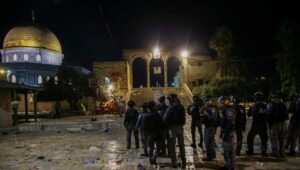Editor’s Note: This is an opinion piece based on a theory promoted primarily by Bob Cornuke, an American Christian in his book Temple. Cornuke describes himself as a biblical archaeologist, but has no degree or training in archaeology. The ideas in this article have been tossed around in Christian circles from time to time over the past few years, but are widely rejected by serious archaeologists. We thought our readers should have a chance to consider the evidence for themselves.
Recently, I came across something that I hadn’t thought possible until recently. It is so bizarre that even Jewish Rabbis had to cry at the presentation and said: “How could we have missed this?” Here’s the story.
Since the conquest of the city of Jerusalem in 1967, intensive research has been done by Jewish archaeologists Benjamin Maser and Ernest Martin, and more recently by Bob Cornuke, all of whom have conclusively demonstrated that the Temple was in the City of David, and not on the Temple Mount as we know it.
No matter how shocking this may sound, there has never been a Temple on the so-called Temple Mount, rather a Roman fortress called Fort Antonio. This fort was built to house 10,000 men (6,000 soldiers and 4,000 support staff) as all Roman forts have a standard size: 35 acres, or 14.2 hectares.
The traditions locating the Jewish Temple on the plateau above the Western Wall are so ingrained that this shocking revelation will continue to be ridiculed and quashed for as long as possible. If archaeologists were to publicly comment on these revelations, they would probably lose their jobs and be defamed.
The fact is that archaeologists have uncovered a Roman amphitheater under the Western Wall, which means that the wall could not be a part of the Jewish Temple.
Bob Cornuke is a former FBI agent and has helped solve countless murder cases. He said about his job as an agent: “If you have the right suspect, all the puzzle pieces will fall into place.” He also located the Mount of Moses in Saudi Arabia (Jabal Al-Lawz), and not in the Sinai Peninsula, as the mother of Emperor Constantine established in the fourth century.
Cornuke has written a book on this entitled Temple: Could History Be So Stunningly Wrong?
An important piece of evidence regarding the location of the Temple is the Gihon Spring, which is situated in the City of David. King David conquered this city from the Jebusites and established the City of David, and it was here that he bought the threshing floor of Ornan in order to make sacrifices to the Lord at the direction of the Angel of the Lord, not on the Temple Mount.
The Romans built water storage cisterns under the so-called Temple Mount that were supplied with water from southern Bethlehem. This water provided for the thousands of men in Fort Antonio. The suggestion has been made that the Temple and the Fort both stood on the same Temple Mount plateau. The way they explain this is that only a small Roman fort for just 600 men was situated adjacent to the Temple complex on the same hill. However, this is illogical. After all, the NT tells us that just to bring the Apostle Paul to Caesarea required a force of 470 Roman soldiers. That means that the Roman’s would leave only about 130 men behind to keep the masses of rebelling Jews under control in Jerusalem. That also is not logical. The Temple Mount is much too small for both the Temple and its surrounding buildings, together with a 6,000-soldier Roman fortress.
The Gihon Spring is the only source of fresh running water in Jerusalem, which was a requirement for the priestly services (Numbers 19). The Roman water storage sites unearthed under the so-called Temple Mount can contain only stagnant water and are absolutely unsuitable for the Temple service of the priests, who required access to fresh running water. This fresh running water was available at the Gihon Spring in the City of David.
Excavations also found an olive press in the City of David. Olive oil was also needed for anointing by the priests. In addition, trenches were found where the blood of the slaughtered animals could flow away.
Another convincing piece of evidence that the Temple was in the City of David is the fact archaeologists found a golden bell there (see video on YouTube with the keyword ‘Golden Bell of the High Priest’).
In Exodus 28:34-35 we find the description of the High Priest, who wore a cloak with 72 golden bells at the bottom of the hem, alternating with 72 pomegranate balls. X-ray analysis found gold threads of 4 mm in these gold bells (approx. 0.5 inch), which functioned as clappers. Exodus 28:35 says that the sound of those bells had to be heard when the High Priest entered the sanctuary.
All sorts of insights have also arisen from statements made by Flavius Josephus, who witnessed the destruction of the Temple in 70 AD. In addition, countless Bible verses all point in the same direction: 2 Samuel 5:7; Joel 3:17; Psalm 132:8,13; Psalm 2:5; Psalm 26:2; Psalm 102; Psalm 9:11; 2 Chron. 3:1; etc.
Another striking piece of evidence is found in Acts 21, where Paul preaches in the Temple and is almost killed by the Jews. The Roman soldiers descend from the barracks via stairs to the Temple to protect Paul. At the top of the stairs, Paul asks to speak to the people in Hebrew. Then the soldiers take him up to the barracks. These stairs, too, were uncovered by Jewish archaeologists, as a connection between the Temple and the Roman Fort, which is now mistakenly regarded as the Temple Mount. Flavius Josephus wrote: ‘The Fort overlooked the Temple.’
The current traditions related to the Temple, which is said to be on the so-called Temple Mount, were probably born in 1099, when Crusaders conquered the mountain and replaced the half-moon Muslim symbol with a cross on the Dome of the Rock (at the time it was not golden). The Pope then declared this place Templum Domini, the Temple of God.
The implications of these discoveries are far-reaching. After all, the Jews could now start building the Third Temple. They are no longer hindered by the presence of the Dome of the Rock and the Al Aqsa mosques. They can build the Temple in the City of David. The Temple Institute has been preparing for its construction. If there was ever a suitable time to rewrite history, it is now.















Solomon would not allow his Gentile wife to live in the City of David, because the temple, where the Ark of the Covenant was located, was holy – so the Temple and the Ark were obviously within the City of David.
2 Chronicles 8:11
Solomon brought Pharaoh’s daughter up from the City of David to the palace he had built for her, for he said, ‘My wife must not live in the palace of David king of Israel, because the places the ark of YHWH has entered are holy.’
Interesting. Contrast that with the story of Ruth the Moabitess who became ancestor of King David and of Jesus of Nazareth.
Ruth committed herself to Naomi, to Naomi’s people and to Naomi’s God. That act of separation from her own people is what holiness is about.